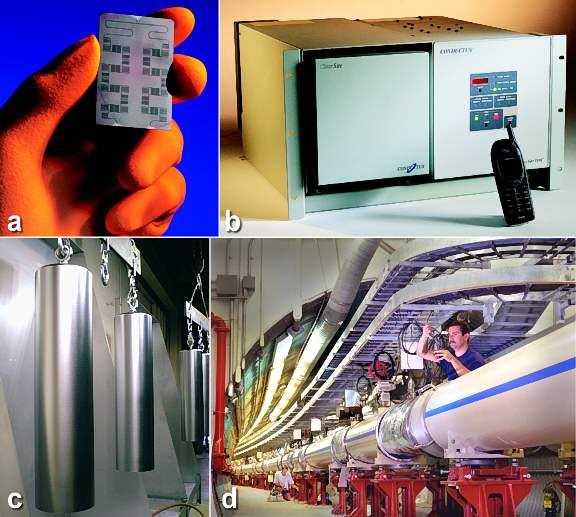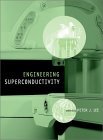Superconductor Applications
Today superconductors can be found in applications as commonplace as MRI systems installed in thousands of hospitals and cellular telephone base stations as well as monumental applications such as particle accelerators. In figure 1 we illustrate two major commercial applications, Magnetic Resonance Imaging, MRI, and high field Nuclear Magnetic Resonance, NMR. The difference in bore size is quite substantial. This page was excerpted from and to publicize the 2001 book "Engineering Superconductivity" (see below) and is getting a little out-of-date. A course on Applied Superconductivity dating from the Fall 2005 semester at MIT and originally prepared and presented by Prof. Terry Orlando is availabe from MIT's Open Courseware project. For advances in superconductors applied to the electrical grid I recommend the actively maintained pages at W2AGZ.
 |
| Figure 1 Low field MRI and high field NMR: a) GE Signa OpenSpeed MRI. This open MRI uses superconducting strand to create a highly stable 0.7 T field. Image courtesy of GE Medical Systems. b) 21.3 T Nb3Sn based superconducting magnet manufactured by Oxford Instruments plc. for a high resolution 900 MHz NMR system by Varian, Inc.. Image courtesy of Oxford Instruments, plc. |
An excellent case in point would be the application of HTS microwave filters in cellular telephone base stations. Superconductor is almost lossless at microwave frequencies and extremely sharp microwave filters can be made, using large numbers of poles, without incurring significant insertion losses. This makes them ideal for use as preselect filters in wireless base stations (1). The combination of high Tc and improved advances in cryocooling means that microwave filter systems can be supplied for base stations in compact, hot-swappable rack- mount units (2). Because they produces clearer signals they not improve service quality but they can increase service area or allow base stations to be built further apart. The accelerated pace at which these units are being installed reflects the competitive economics of the new technology.
 |
| Figure 2. Small and large scale superconductors and their applications: a) YBa2Cu3O7-d based microwave filter for b) rack mount front-end receiver subsystem for cellular telephone base stations, images courtesy of Conductus, Inc.(now STI) c) 136 kg Nb-47wt.%Ti alloy billets are destined for accelerator application. Each billet is 750 mm tall by 200 mm diameter. Image courtesy of Wah Chang. d) A view of the superconducting magnets at Brookhaven National Laboratory's Relativistic Heavy Ion Collider (RHIC). The 1,740 Nb-Ti based magnets guide and focus gold particles along the collider's 4 km long tunnel at nearly the speed of light. Image courtesy of Brookhaven National Laboratory. |
Superconducting current leads
The large currents the superconductors can carry must somehow be carried to the cooled superconductor from ambient temperature. Prior to HTS this has usually been the primary loss of heat for superconducting devices because metals with high enough electrical conductivity to carry the huge currents also have high thermal conductivity. This heat loss has, in the past, significantly reduced the cost effectiveness of superconductor applications. HTS represents a breakthrough in this area because ceramics are not good thermal conductors. Of course they cannot take supercurrent all the way to room temperatures (as of this writing) and account must be made of their sensitivity to magnetic field but they can be used as a high current thermal block. Combination normal/superconducting current leads are commercially available using BSCCO 2212 and 2223 and YBCO HTS superconductors. HTS leads make both LTS and HTS superconductor applications more economically viable.
And what of the future?
We have come to expect a continuous improvement in superconductor properties and nothing that we have seen over the last twenty years leads us to expect otherwise. This certainly impacts power and other applications where the competition is copper, which is very little improvement over the last fifty years. Increasing energy costs (and the effects of deregulation in the U.S.) will also benefit the competitiveness of superconductors in power applications such as generators (3). Environmental issues should also positively impact the application of superconducting power transmission cables. One such cable was installed at the Detroit Edison Frisbee substation in downtown Detroit and designed to triple power throughput in an existing facility. For that project American Superconductor shipped 4.25 miles of HTS wire to Pirelli for cable assembly in August 2000. SMES (see: "engineering Superconductors" Power Quality, section: MicroSMES) is already commercially available today and is competitive with conventional systems for some applications. A 1000 hp superconducting is being developed using HTS technology (4). The development of 10 kWh superconducting flywheel system was initiated by Boeing and ANL in 1999. There are several investigation of HTS based fault current limiter technologies that look promising (see Superconducting Fault Current Limiters). High temperature superconducting (HTS) transformers are being developed including one by IGC, Waukesha Electric and ORNL which has so far resulted in a 3-phase, 1 MVA unit (5).
Improved properties developed in Nb3Sn strand during the R&D production phases for the CS model coil of the major international magnet confinement fusion reactor project ITER, have made possible much lower cost alternatives to the original design that could make Fusion power a reality as an enduring low-carbon energy source. The success of the of the ITER CS model coil shows that brittle superconductors, like A15 Nb3Sn, can be made into very large scale magnets that can be used at high fields in demanding applications (see Figure 2).
 |
| Figure 2 a) The world's most powerful pulsed superconducting magnet, the150 ton 13 T (approximately 260 thousand times more powerful than the earth's magnetic field) ITER CS Model. The magnet consists of two modules, the inner module (b) fabricated in the US and the outer fabricated in Japan. The two coils were combined at the Naka Fusion Research Establishment test facility of the Japan Atomic Energy Research Institute, JAERI. Photos courtesy of and copyright retained by JAERI. |
The Large Hadron Collider (LHC) ring at CERN on the Swiss/French border near Geneva has a 27-km ring containing 1624 superconducting magnets (1232 15 m long dipoles and 392 5-7 m long quadrupoles) manufactured using Nb-Ti superconductor which is cooled down to 2 K and provide a magnetic field of almost 9 T. The designed collision energy is 14 TeV. Already superconductors are being developed that can make a 100 TeV collider possible.
Bibliography
1. M. J. Scharen, D. R. Chase, A. M. Ho, A. O'Baid, K. R. Raihn and R. J. Forse, Filter subsystems for wireless communications, IEEE-Trans. Appl. Superconductivity, 7 (2.3): 3744-9, 1997.
2. Y. Ueno, N. Sakakibara, T. Yamada, M. Okazaki, and M. Aoki, High-temperature superconducting receiving filter subsystem for mobile telecommunication base station, IEICE Trans. Electronics, E82-C (7):1172-6, 1999.
3. W. V. Hassenzahl, Applications of superconductivity to electric power systems, IEEE Power Engineering Review, 20 (5): 4-7, 2000. And W. V. Hassenzahl, More applications of superconductivity to electric power systems, IEEE Power Engineering Review, 20 (6): 4-6, 2000.
4. D. Driscoll, V. Dombrovski, and B. Zhang, Development Status of Superconducting Motors, IEEE Power Engineering Review, 20 (5): 12-15, 2000.
5. B. W. McConnell, S. Mehta, and M. S. Walker, HTS Transformers, IEEE Power Engineering Review, 20 (6): 7-11, 2000.
6. A history of MRI can be found at: http://www.isbe.man.ac.uk/personal/dellard/dje/history_mri/history%20of%20mri.htm
Excerpted from "Engineering Superconductivity," ed. Peter J. Lee, Wiley-Interscience, New York, 2001

Link: Contents
of and Contributors to "Engineering Superconductivity"
Created April 18 2002 ©Peter J. Lee
Applied
Superconductivity Center
Directions to ASCFacilities
Group Members
Image Gallery
Plots & Spreadsheets
Publications & Presentations
Research
Superconductor History
Thesis Archive + ASC Alumni
Peter Lee
Bio
Recent Publications
Some Older Publications
ImageJ/Fiji Macros for Image Analysis
Applied Superconductivity:
Conferences
Applications
Terms & Definitions
Contact:
The Applied Superconductivity Center
Frank Shaw Bldg.,
2031 E. Paul Dirac Dr.
Tallahassee FL 32310-3710 USA